 |
|
|
|
|
 How To Solve Puzzles
How To Solve Puzzles
How to Solve Diagramless Crossword Puzzles
by Roy Leban
If you’ve never solved a diagramless crossword puzzle, you’re in for a treat. Diagramless puzzles offer all the challenges of regular American-style crossword puzzles with the extra challenge of figuring out the grid. To top things off, they look impossible at first (but they’re not).
The Basics
There’s a lot to take in, but start with the rules. Diagramless crosswords follow all the rules of regular crosswords and then some. There are no isolated squares and no two-letter words. Every letter in the grid is used in both an Across and Down answer. Each clue is numbered, starting with 1 for the first clue in the top row and increasing left-to-right and top-to-bottom. Every number in the grid is used by either an Across clue or a Down clue, or one of each. But, the puzzle starts with a blank grid, and it’s up to you to figure out where each answer goes.
Unlike regular crosswords, a finished diagramless crossword almost always makes an interesting shape. This shape will touch all four edges of the grid that you’re given — top, bottom, left and right.
Some puzzles will provide some starting information in the Introduction, including the location of 1-Across (and 1-Down, too) and the symmetry of the puzzle. If you want the extra challenge of figuring these out, hide the introduction quickly when you open the puzzle. You can always show it later if you want.
For puzzles where the 1-Across location is not specified in the introduction,
you can still learn it by tapping on the
 icon
at the top of the screen and turning on the Shade Starting Cell hint.
This will highlight where clue number 1 goes in the grid.
(Note: if a puzzle does not include a solution, this hint is not available.)
icon
at the top of the screen and turning on the Shade Starting Cell hint.
This will highlight where clue number 1 goes in the grid.
(Note: if a puzzle does not include a solution, this hint is not available.)
At the top of the on-screen keyboard, you’ll find several keys which will help you solve. These are explained in more detail below.
Getting Started
So how do you get started? It’s easier to start at the top for a few reasons.
First, because the puzzle’s shape touches the top and bottom of the gird, the first Across answer is always in the top row and the last Across answer is always in the bottom row.
Second, you can tell the length of the 1-Across answer by looking at the second Across clue and subtracting 1 from its number. If the second clue is 5-Across, this means that 1-Across’s answer has to be 4 letters long. This is true for all answers in the top row, but you don’t know how many answers are in the top row. Taking this principle further, if less than three numbers separate two of the early Across clues, then you can tell that they’re not in the top row. For example, if you have 1-Across, 5-Across, 9-Across, and 11-Across, then 9-Across can’t be in the top row because it would have to be a 2-letter word. This helps you narrow down what the top looks like.
Third, we are better at guessing words given the first letter(s) than given the last letter(s), so we have a better shot at getting 1-Down, 2-Down, etc. than the words which end in the last Across answer.
And, fourth, many, but not all, diagramless crosswords will start with a few easier clues at the top to help you get started. (In general, you’ll find diagramless clues are easier than most Crossword clues.)
Clue Notes
If you know the answer to a clue but don’t yet know where it goes in the grid, you can make a note on the clue by pressing and holding on the clue, then entering the answer in Clue Options. As you’re solving, these notes will help, for example, when you’re looking for a crossing word with a particular letter in it. Unlike in a regular crossword, you may not know the length of an answer. While you don’t need the length to know that “President Barack” is definitely OBAMA, “President George” could be WASHINGTON or BUSH. But, even this limited knowledge of possible answer lengths may help you figure out how the grid goes together.
Placing Answers and Blocks
When you open a puzzle, you’ll notice that there are clue numbers all across the top row
and down the left column. You can ignore these at the beginning.
You’ll also see that an entire row or column is selected at any given time,
rather than just a single answer space. This is because the answer space is up to you to determine.
Like in a regular crossword, tap in the selected cell to change directions, or you
can use the cursor keys or the Switch Direction key
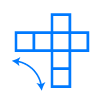 .
If the cursor keys and the
.
If the cursor keys and the
 key
are not shown, turn them on with the Cursor Keys option under
Settings (
key
are not shown, turn them on with the Cursor Keys option under
Settings ( ).
).
Whether you know where clue number 1 goes or not, you don’t need to worry about it too much because it’s easy to move things around in the grid. As was mentioned previously, the length of 1-Across is known, so start there. Next, see if you can figure out the intersecting Down answers given their first letters from 1-Across. These intersecting words might be different lengths. And then, see if you can find an early Across answer which intersects the second or third row of those Down answers. (Remember, an answer might start to the left of 1-Down.) If you can do all this, you’ll have a nice solid block to start with.
As you figure out the first section in the grid, just enter it in the grid at the top.
When you place an answer in the grid, you’ll normally use the Block key
 to insert a block on
each side of the answer.
You’ll do this because all answers begin and end either adjacent to a block or at
the edge of the grid.
When you add blocks, all the numbers in the grid will update to reflect the new blocks.
When you’re first starting a puzzle, this won’t help much, but as you get more of the grid defined,
it will make a big difference as you’ll get a better and better idea of where the numbers go.
to insert a block on
each side of the answer.
You’ll do this because all answers begin and end either adjacent to a block or at
the edge of the grid.
When you add blocks, all the numbers in the grid will update to reflect the new blocks.
When you’re first starting a puzzle, this won’t help much, but as you get more of the grid defined,
it will make a big difference as you’ll get a better and better idea of where the numbers go.
The blocks on the outside of the grid and the blocks on the inside of the grid are somewhat different. There are usually lots of blocks on the outside to define the shape and very few, if any, on the inside. When people solve on paper, they sometimes don’t mark the outside blocks, but you’ll want to mark them in Puzzazz because they affect the numbering. When you successfully solve a puzzle, Puzzazz will automatically change the look of the outside blocks to help delineate the shape better (this only happens if the puzzle includes a solution).
Moving Things Around
Especially as you first get started in a diagramless puzzle, you’ll need to move your answers around. Puzzazz provides functions to do precisely this. When you have a row in the puzzle selected, a set of row manipulation keys will be shown; when you have a column selected, a set of column manipulation keys will be shown. When you have a clue selected, Mark Clue Solved and Unmark Clue Solved buttons will be shown; these can be useful to help you keep track of which clues you have already solved.
The Move keys
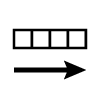
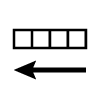
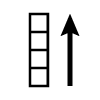
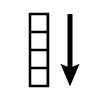 move an entire selected row or column in the indicated direction without wrapping around.
The first cell becomes an empty cell and the previous contents of the last cell are removed.
To move multiple rows or columns, tap in each one and then tap the appropriate Move key.
move an entire selected row or column in the indicated direction without wrapping around.
The first cell becomes an empty cell and the previous contents of the last cell are removed.
To move multiple rows or columns, tap in each one and then tap the appropriate Move key.
The Split keys
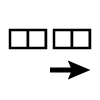
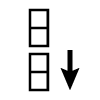 and Merge keys
and Merge keys
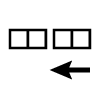
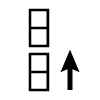 are used to move portions of rows and columns around.
The Split keys move the portion of the row or column starting at the cursor to the right or down.
The contents of the cell in the rightmost column or bottom row are removed.
Conversely, the Merge keys move the portion of the row or column starting at the cursor back to the left or up.
The contents of the selected cell are replaced with the value moved in,
and an empty cell is added at the end of the row or column.
are used to move portions of rows and columns around.
The Split keys move the portion of the row or column starting at the cursor to the right or down.
The contents of the cell in the rightmost column or bottom row are removed.
Conversely, the Merge keys move the portion of the row or column starting at the cursor back to the left or up.
The contents of the selected cell are replaced with the value moved in,
and an empty cell is added at the end of the row or column.
The Insert keys
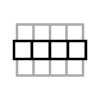
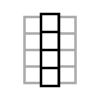 and Delete keys
and Delete keys
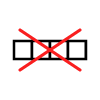
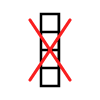 are used to manipulate entire rows and columns.
The Insert keys insert an empty row or column in place of the selected row or column,
moving the contents of the selected row or column along with the rows below or columns to the right over.
The contents of the bottom row or rightmost column are removed.
Conversely, the Delete keys delete a row or column,
moving the rows below up or the columns on the right to the left.
The contents of the current row or column are replaced with the row or column moved in,
and an empty row or column is added at the bottom or right.
are used to manipulate entire rows and columns.
The Insert keys insert an empty row or column in place of the selected row or column,
moving the contents of the selected row or column along with the rows below or columns to the right over.
The contents of the bottom row or rightmost column are removed.
Conversely, the Delete keys delete a row or column,
moving the rows below up or the columns on the right to the left.
The contents of the current row or column are replaced with the row or column moved in,
and an empty row or column is added at the bottom or right.
Symmetry
If you know the symmetry of the puzzle, either because it was given to you in the
introduction, or you’ve figured it out, you can turn on symmetry enforcement
by tapping on the
 icon
at the top of the screen and setting the Grid Symmetry.
When you do this, every time you add or remove a block, the symmetric blocks will
also be added or removed. This can be really helpful as you’re finishing up a puzzle,
but it can get in your way early on, or if you’re not sure about the symmetry.
You can turn it on once you’ve established the basic shape of the top of the puzzle.
icon
at the top of the screen and setting the Grid Symmetry.
When you do this, every time you add or remove a block, the symmetric blocks will
also be added or removed. This can be really helpful as you’re finishing up a puzzle,
but it can get in your way early on, or if you’re not sure about the symmetry.
You can turn it on once you’ve established the basic shape of the top of the puzzle.
The most common type of symmetry is 180° symmetry, in which the shape looks the same when you rotate it 180°. But, a puzzle can also use 90° rotation or be mirror symmetric up-down or left-right, or in both directions. Or it can have no symmetry at all. If you think you’ve figured out the symmetry, be careful — you might be wrong. For example, a 4-leaf clover shape might appear left-right or 4-way mirror symmetric until you get to the stem at the bottom which curves one way or the other.
Note: Like the location of 1-Across, some puzzles provide the symmetry as a hint. If this is the case, there will be a * next to the correct symmetry in the list of choices.
Other Tips
Pretty much everything you’ve learned about crosswords also applies to diagramless crosswords, though generally with fewer tricks and tricky clues (for example, it’s an extremely rare diagramless crossword that uses rebuses). If you’re just getting started, it’s not a bad idea to review Puzzazz’s How to Solve Crossword Puzzles.
If a clue number is used by both an Across clue and a Down clue, the number is in a corner. This means that there will be a block both above and to the left of the number. You can use similar techniques described for 1-Across and 1-Down, combined with other information you’ve already figured out, to make progress starting from a corner.
If you have placed blocks such that there is an isolated empty cell or there are two isolated empty cells in the same row or column, those cells must be blocks. This most frequently happens between a block you have placed and the edge of the grid.
For puzzles with standard symmetry, if the puzzle has an odd number of Across clues, the middle clue will be in the middle row and will have a length which will match the width of the puzzle in being either odd or even. The same is true for the Down clues. If there is an odd number of both Across and Down clues, the two middle answers will intersect in the center of the grid. Similar logic can also be used for non-standard symmetry. For example, in a puzzle with a left-right symmetry, the middle clue of an odd-length Down clue list will be in the middle column.
Grids are normally completely connected. That is, there will be no row or column which does not have at least one entry in it.
Last, but not least, you may encounter a rare puzzle that breaks some of the rules. Sometimes, a constructor wants to stretch the limits of what’s possible and they have a really good reason for breaking a rule. Be alert.
Hints
In addition to the 1-Across hint and the possible symmetry hint mentioned above,
don’t forget you can get hints by tapping on the
 icon.
You can reveal the contents of any cell in the grid and also clear out errors.
It’s not cheating to ask for a hint — the goal is to
have fun, so if asking for a hint increases your enjoyment, feel free.
icon.
You can reveal the contents of any cell in the grid and also clear out errors.
It’s not cheating to ask for a hint — the goal is to
have fun, so if asking for a hint increases your enjoyment, feel free.



|
Our Puzzle Books Buy Gift Certificates
Our World-Class Authors
How to Solve Puzzles
Our exclusive, award-winning TouchWrite™ handwriting recognition
Special features: Puzzles Live 2013 100th Anniversary of the Crossword
Get the puzzle of the day:
Read the latest Puzzazz Newsletter
About Us Contact Us Support FAQ Read the Buzz about Puzzazz
Your account Redeem a coupon or special offer
Cookies: If you sign in, we use a cookie for that purpose. We also use cookies to manage your browser session.
If you use third-party services, such as Facebook, with Puzzazz, they may use cookies following their own policies.
© 2026 Puzzazz Privacy Policy



